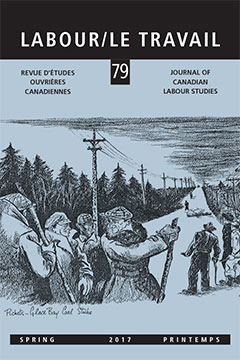Published 2017-05-11
How to Cite
Abstract
The Gouzenko Affair is referred to as the event that started the Cold War. This article draws on recently declassified documents that shed new light on Britain’s role in this affair, particularly that of the Foreign Office and the British High Commissioner to Canada. The documents reveal how the British had a major part in directing the response to Igor Gouzenko’s defection in 1945. This event revealed the need for increased counterespionage security, but it also became a spectacle that directed the public’s attention away from the British connection: specifically, the role of Alan Nunn May, a British nuclear scientist who had provided the Soviets with classified information. Instead, the public’s interest was centred on Soviet spies, communism as a subversive force, and the brewing Soviet-US conflict. These newly declassified sources demonstrate how it was the British intelligence services and the British government that went to great lengths to help focus the public’s attention in this direction. They took great pains to direct Canadian policymaking, which included working to discourage Canada’s prime minister William Lyon Mackenzie King from handling the affair privately with the Soviet ambassador, and were likely behind the infamous press leak to US reporter Drew Pearson that forced King to call a Royal Commission and publicize the affair. With the help of the British government and intelligence services, the Cold War began.
L’affaire Gouzenko est désignée comme l’événement qui a commencé la guerre froide. Cet article s’appuie sur des documents récemment déclassifiés qui jettent une nouvelle lumière sur le rôle de la Grande-Bretagne dans cette affaire, en particulier celui du bureau des affaires étrangères et du haut commissaire britannique au Canada. Les documents révèlent comment les Britanniques ont joué un rôle majeur dans la réponse à la défection d’Igor Gouzenko en 1945. Cet événement a révélé la nécessité d’une sécurité accrue de contre-espionnage, mais il est également devenu un spectacle qui a détourné l’attention du public britannique : plus précisément, le rôle d’Alan Nunn May, un scientifique nucléaire britannique qui avait fourni aux Soviétiques des informations classifiées. Au lieu de cela, l’intérêt du public était centré sur les espions soviétiques, le communisme en tant que force subversive et le conflit émergent soviéto-américain. Ces sources nouvellement déclassifiées démontrent comment les services de renseignements britanniques et le gouvernement britannique ont fait de grands efforts pour attirer l’attention du public dans cette direction. Ils se sont efforcés de diriger l’élaboration des politiques au Canada, ce qui a consisté à décourager le premier ministre du Canada, William Lyon Mackenzie King, de traiter l’affaire en privé avec l’ambassadeur soviétique et ils étaient probablement derrière la fameuse fuite de la presse au journaliste américain Drew Pearson, ce qui a obligé King de faire appel à une commission royale et faire connaître l’affaire. Grâce à l’aide du gouvernement britannique et des services de renseignements britanniques, la guerre froide a commencé.
